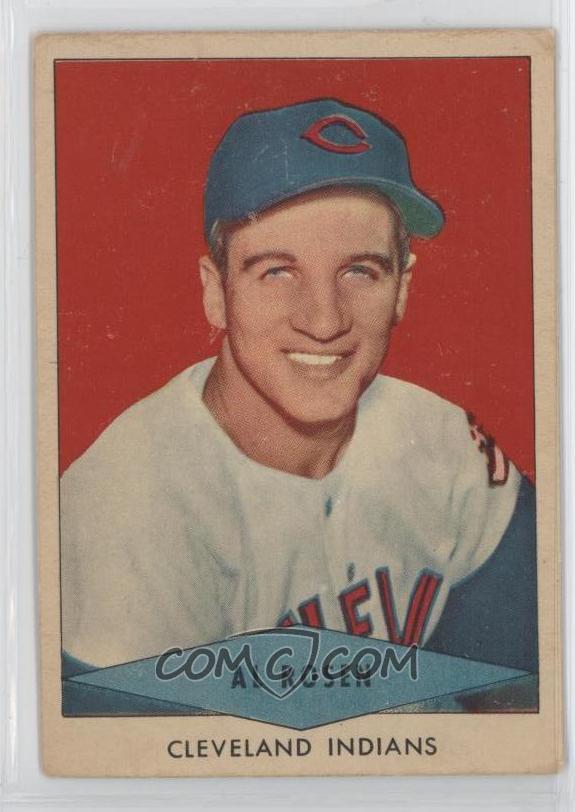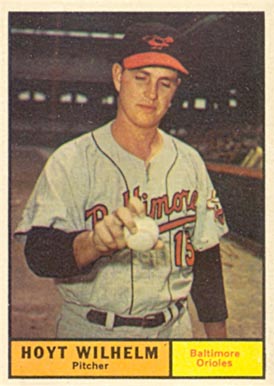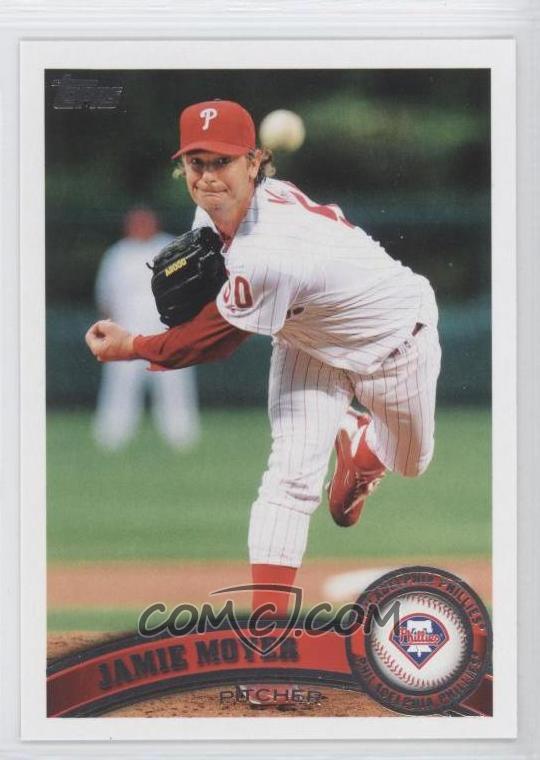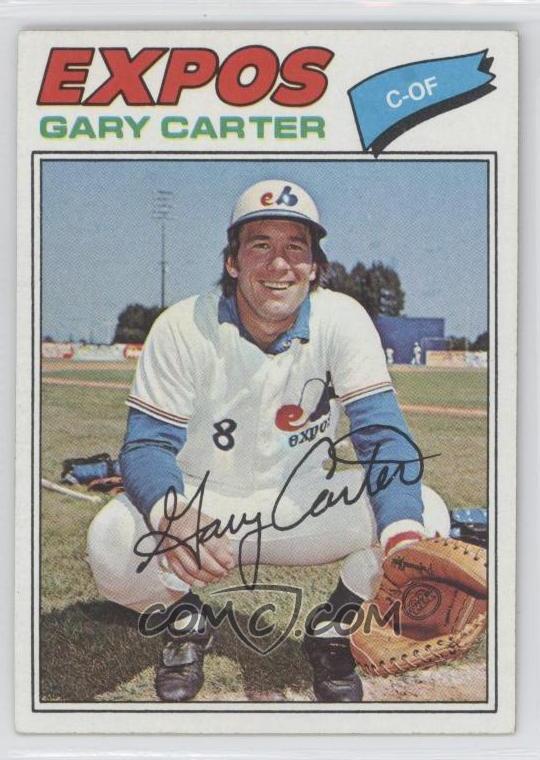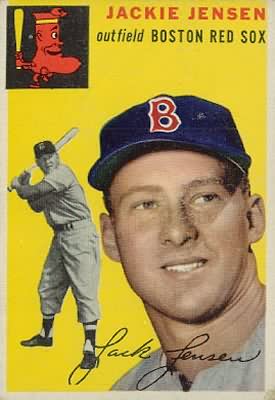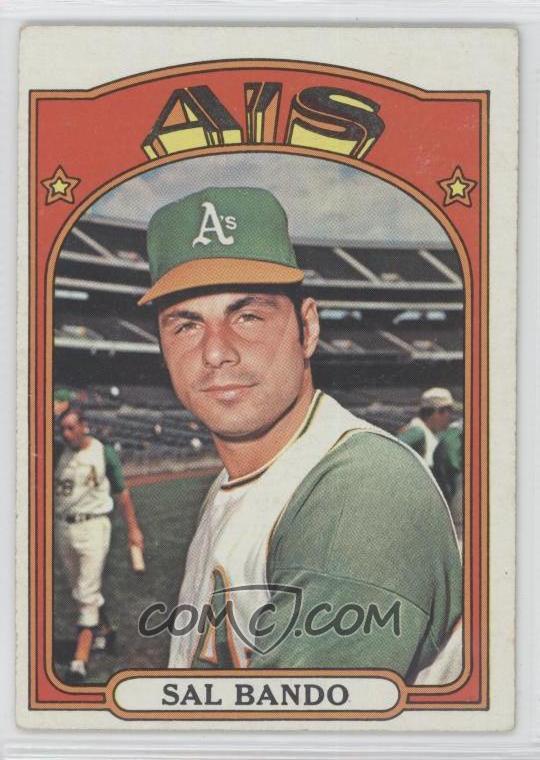Wednesday, February 29, 2012
Off Season Winners and Abject Disappointments, 2012
Last year, The Common Man ranked the offseasons, and came down decidedly in the favor of the San Diego Padres doing the best job maximizing the resources they had on hand. It's hard to argue that their entire season was a big disappointment, but GM Jed Hoyer had put the club on solid footing. Conversely, TCM was incredibly down on the Minnesota Twins, whose refusal to improve their depth, and the Angels, who missed out on their free agent targets and decided to make a splash with Vernon Wells instead. Both clubs severely disappointed their fans. (Of course, in the interest of transparency, TCM was way down on the New York Yankees' moves last offseason, and the clubs' pitching acquisitions helped them win 97 games.)
Now that we finally know that Roy Oswalt isn't going anywhere for a while, and where Juan Rincon landed, it's time to do it all over again. TCM was surprised how few of the offseasons he was down on this year. Glaring mistakes not committed by Dan Duquette were hard to come by, and teams that did overspend for some players made excellent moves in others.
So where does your team rank?* Hit the jump to find out:
Happy Birthday...Leap Day Edition
So, today is a month-and-day combination that hasn't happened since 2008, and won't happen again for four years. I started blogging in earnest in April of 2009, and four years from today, we could all be dead. So I thought we'd better celebrate all the players born on February 29 all at once. It could be our only chance!
I've never known anyone to have been born on February 29, and I'd be curious to know what their childhoods were like. I mean, I assume you just have a birthday party on three of every four February 28ths or March 1sts, but it has to be a bit different, right?
I digress. Counting down from least-good to best, here's a look at the six Leap Day-born players who compiled at least 1.0 career rWAR (apologies to Ed Appleton, Al Autry, Jerry Fry, Ralph Miller, and Roy Parker):
Monday, February 27, 2012
On Multiple Allegiances
Friday, February 24, 2012
Jose Canseco Math
by Jason Wojciechowski
Jose Canseco is tremendous.
home runs should not count if you lose and count doble if you win
— Jose Canseco (@JoseCanseco) February 25, 2012
You were surely silently asking for the career home-run list by Canseco Math. Here is the top 40 in real-lifers (just to choose a round number that includes Canseco).
How the Indians Lost the 1959 Pennant
Some of you may have heard that The Common Man is going to be controlling the Cleveland Indians in friend of the blog Jeff Polman’s Strat-o-Matic replay of the 1958 season, in conjunction with his online mystery novel. It should be a lot of fun.
To get ready, The Common Man combed through as much info on the ’58 Tribe as he could and came to the realization that General Manager Frank Lane was an absolute idiot.
You remember Frank Lane, undoubtedly, as “Trader” Lane or “Frantic” Frank. He was an executive who simply couldn’t leave his roster alone, constantly tinkering with it, making huge trades, and generally getting in his own way. In 1958, as usual, he was active. He deal Chico Carrasquel to the A’s for light-hitting shortstop Billy Hunter. He also pulled off a five player deal, sending Roger Maris and some change to the A’s for Vic Power and Woodie Held. It was all largely window dressing, as the Indians were 7.5 games out on June 1 and never got much closer. But late in August, Lane made another change that, honestly, made no sense.
Braun Over Brains: On "Technicalities," Precedent, and Confidentiality
 |
| This picture is a stupid joke but I think it’s funny |
About all of this, I have a few things to say.
First: I had a conversation with someone on Twitter today who told me that he still believes Braun used "PE"Ds, even though his case came out in his favor. This is exactly why confidentiality is supposed to be part of the testing program. Appeals happen in the dark and if the player wins, no member of the public is ever the wiser, thus preserving that player's reputation.
Thursday, February 23, 2012
What Do Minor League Walk and Strikeout Rates Tell Us About Prospects? Single A Edition
Introduction
A few months ago, I created a database that includes all of the prospect rankings from Baseball America, Keith Law and Kevin Goldstein. I didn't have a direct purpose for it, I'm just the type of person who likes to accumulate as much data as possible. So it sat around on my computer until I found a good use for it. Well, thanks to fantasy baseball and Starling Marte's horrible 3.8% walk rate in AA last season, I have. Marte is a possible target in my dynasty minor league draft and I wanted to see what other prospects had poor walk rates and how successful they were in their careers.
Method
In interest of saving digital space (and your scrolling finger), I will only post the full method on the Rookie and Low-A edition of this series.
I have added a new feature, which includes 2007-2012 prospects. I followed exactly the same procedure as before in determining the very low to very high categories for current prospects or younger players. I listed only the top 10 or so for each category, instead of all players who fit that description.
History
Rookie and Low-A
Single-A
285 of the 480 prospects in this dataset accumulated at least 150 plate appearances in Single-A. This is quite a leap from the 111 number in Low-A, so the overall numbers here are a bit more interesting. 19% were successful, 20% were average and 61% were busts. This is much closer to the overall 21/21/58 trend for all prospects.
Walks
Jamie Moyer's Potential Firsts
I just wrote about Moyer right around a month ago. But he's taking the field now, stirrups and all, and, well, I can't help it. I'm excited about it. I still don't expect him to make an appearance in the big leagues this year, but just the fact that he might is so freaking cool.
So, quickly. If he does make the majors this year, here are some records he can set:
- First pitcher age 49 or older ever to earn a win. The only two 49 year olds ever to pitch in the major leagues were Hoyt Wilhelm and Jack Quinn; both pitched exclusively in relief, totaling 41 innings, and each had one loss and one save, but no wins. The only pitcher older than 49 was Satchel Paige, who made his one novelty start for the Kansas City Athletics at age 58 (at least) in 1965, but lasted only three innings.
Wednesday, February 22, 2012
Scott Miller's Childish Faith of a Child
This happened to The Common Man with Kirby Puckett, a dumpy, perpetually smiling highlight reel with a funny name and who looked fairly ridiculous at the plate until he'd hit a baseball really, really hard, and who seemed to handle the abrupt end of his career with grace and dignity. It turned out that Kirby Puckett wasn't nearly as nice as he was portrayed on TV, in magazines, in newspapers, and in his autobiography (which The Common Man owns in both its adult and children's editions). It turns out that Kirby Puckett, in addition to being a really good baseball player who loved to play the game and smile a lot was also a womanizer and allegedly a sex offender.
This is not to pile on to Puckett, who The Common Man is absolutely incapable of viewing rationally as either a ballplayer or a human being, given how hard he rooted for him in real life and how much of a part of TCM's childhood Puckett was. Puckett helped make The Common Man a baseball fan, and TCM will always be grateful for that, and for Puckett's incredible performances in the clutch that helped the Twins win two World Championships.
Tuesday, February 21, 2012
What Do Minor League Walk and Strikeout Rates Tell Us About Prospects? Rookie League and Low A Edition
Introduction
A few months ago, I created a database that includes all of the prospect rankings from Baseball America, Keith Law and Kevin Goldstein. I didn't have a direct purpose for it, I'm just the type of person who likes to accumulate as much data as possible. So it sat around on my computer until I found a good use for it. Well, thanks to fantasy baseball and Starling Marte's horrible 3.8% walk rate in AA last season, I have. Marte is a possible target in my dynasty minor league draft and I wanted to see what other prospects had poor walk rates and how successful they were in their careers.
Method
I decided to only look at hitting prospects who appeared on a Baseball America list from 1990 to 2006, a total of 480 players. This provides an ample amount of time for us to know how the prospect fared in his career. Then, I took minor league plate appearance, walk and strikeout data from 1987 to 2011 from Baseball Prospectus. The Rookie league data may not be complete, but should be extremely close. Then I added Fangraphs WAR and other assorted Major League offensive metrics for each prospect.
I removed all minor league data after a player accumulated 100 Major League PAs, removing rehab and non-prospect years. Then I created level average metrics by year: BB/lvlBB*100 and SO/lvlSO*100. This doesn't account for the various leagues (International versus Pacific in AAA) but it's better than nothing. I calculated a weighted average for players who spent multiple years in the same level.
Next, I wanted to account for small sample sizes, so I only looked at players who accumulated more than 150 total plate appearances per level. Then I calculated a variance for each player from the average for qualified players at each level for both walk and strikeout rate: (BB/PA+ - average BB/PA+ for qualified players)/Standard deviation BB/PA+. Finally, I split players into categories of Very Low, Low, Average, High and Very High, based on this variance.
Friday, February 17, 2012
Gary Carter's Best Day in Baseball
I imagine that Gary Carter, who passed away yesterday at just 57 years of age, would've told you his best day involved a lot of time spent with his wife, children and/or grandchildren. I'm just as sure that he'd have his own idea of what his best day in baseball was -- his two-homer game in the World Series would be a good bet, or the time he caught Charlie Lea's no-hitter. (Odd, sad side note: Lea, two and a half years younger than Carter, died after a heart attack just three months ago.) Here, I'm going to focus on the regular season, and mostly on hitting. What was the single greatest game of Carter's career?
There's a lot to choose from, obviously. Carter was a Hall of Famer (and a more than deserving one) who appeared in 2,296 games, and 2,056 of them as catcher -- fourth most all-time. He had twenty-eight career multi-homer games, 105 games with at least three hits, 42 with four or more RBI [edit: I was looking at incomplete data, so had to fix the numbers]. But here, subjectively selected and ordered, are what might be his five best:
Thursday, February 16, 2012
Ray Ratto stretches and stretches
by Jason Wojciechowski
 |
| So studly Photo by Jeffrey Beall |
Ray Ratto is not the most rigorous of thinkers you'll encounter in your everyday baseball-fan life, but I was still a little surprised to see this headline on a piece yesterday morning: "Is Cespedes Oakland's Lin?"
First thought: "Oh, this is exciting. It'll be a one-word column ('No') and we can get on with our lives!"
Second thought: "First thought was delusional."
You can guess, without even clicking the link, who was right.
Ratto's argument, in bullets:
-
Baseball needs a Tebow/Lin.1
Pteromerhanophobia, AJ Burnett, and Jackie Jensen
This morning, we learned that AJ Burnett has officially rejected a trade to the Angels, citing his desire to play on the East Coast. On the surface, it seems ridiculous. Burnett is clearly not wanted in The Bronx anymore, by either the Yankees or the fans, and the Angels have a low-pressure rotation spot that he’d be ideal for as he seeks to right his career. So why…why on Earth, would AJ Burnett refuse the trade?
According to a commenter on one of Rob Neyer’s latest posts (h/t to Rob's Tweet) there is speculation that Burnett’s committed to staying on the East Coast for family reasons. Burnett lives in Maryland in the offseason and, based on some of the provisions of his contracts with the Blue Jays, the team paid for limousine service for Burnett’s wife and children to drive the 8 hours from Baltimore to Toronto several times during his stint there. The speculation is that Burnett’s wife may be deathly afraid of flying, and playing on the East Coast allows him to get back to see his family more regularly, since they can’t come extreme distances to him. The Common Man has no idea whether this is true, nor if it is does he think that anyone in the Burnett family deserves any measure of criticism for their decisions.
What interests The Common Man is that this is in no way the first time that a fear of flying has potentially derailed a promising baseball career.
Wednesday, February 15, 2012
My Markakis Manifesto
Hey everyone, I'm Chris St. John (@stealofhome on Twitter). First, I would like to thank Bill and The Common Man for the opportunity to write at TPA. I will probably be fairly intermittent with my posts, but I just couldn't pass up this great chance to contribute on such a well-respected site. They asked me to come aboard to have someone who could "really dig in and work with the stats," so I have been thinking really hard about my first post. Something deep. Something technical. Something game-changing. Instead, you're going to get something about Nick Markakis. But hey, there's a graph!
My obsession with Markakis began last June when I ran a very simple Bill James favorite toy calculation for Beyond the Box Score on players who are most likely to get 3,000 career hits. I found that Markakis had one of the highest probabilities for an under-30 player to reach that (totally arbitrary) plateau. The conclusion I reached is that his high probability is linked to his consistent ability to stay healthy and get hits. While he has never led the league in hits, he has always surpassed 180, with the exception of his first major league season. However, the more I look into his career, the more I notice that his amount of games played and hits are nearly the only consistent thing about him. His batting average has fluctuated from .284 to .306. wOBA: .334 to .389. TAv: .264 to .310. His peripheral stats vary quite a bit as well. But no matter how he approaches the plate, he shows up for 160 games and gets 180 hits. What I found is that whenever his BABIP goes down, his total amount of balls in play goes up, which makes sense. Both 2 x 3 and 1 x 6 equal six, but the numbers that it takes to get there change.
Monday, February 13, 2012
Happy Birthday...
As a birthdate, February 13 suffers from a shortage of great players -- Bando's 242 career homers are more than four times as many as #2, and no pitcher amassed 50 wins or 500 strikeouts -- and is largely devoid of current players, so it's not likely to get better any time soon.
What it's not missing, though, is interesting stories. Tragic figure Donnie Moore would have turned 58 today; villainous figure (and just plain terrible baseball player who nonetheless got to play for 15 years) Hal Chase was spawned 129 years ago on this date.
If you've read this, though, you know I have to pick Bando to talk about today, who, along with a slew of more or less equally excellent third basemen, is one of the most underrated players in baseball history. Bando woke up this morning as a brand new sixty-eight year old.
Thursday, February 9, 2012
Fighting The Latest "Performance Enhancers"
Yesterday, we learned that George Brett and his company are being sued for making false medical claims about "Ionic Necklaces," which are similar to the Phiten necklaces that MLB players have been wearing since 2010. Brett's necklaces, according to Brett, "help customers relieve pain in the neck, shoulders and upper back, recover from sports fatigue and improve focus. The company has also falsely claimed its bracelets, which include two roller magnets, would relieve wrist, hand and elbow pain, the lawsuit said."
Phiten's product, meanwhile, supposedly "helps to promote stable energy flow throughout the body. The benefits of this are longer lasting energy, less fatigue, shortened recovery time and more relaxed muscles” using "aqua-titanium technology" according to the product description.
So, magnetism and metal dispersed in water. That's what these guys sell to athletes. In return, the products are supposed to boost athletic performance by helping move energy around, or promoting healing, or energizing your particles, or some such nonesense.
Here's The Common Man's question: Isn't that what Performance-Enhancing Drugs are supposed to do? Steroids and HGH are both ways for athletes to gain a competitive advantage on their opponents with the aid of technology and chemistry. Isn't this the same thing, except delivered in a fashion accessory rather than a needle?
2012 Topps: My Last Year of Collecting
2012 marks the end of my baseball card collecting era.
Tuesday, February 7, 2012
The Many Miracles of Rick Ankiel
by Jason Wojciechowski
Do you remember when Rick Ankiel was awesome? I do, by god. Twice, in fact. I remember when he was a 20-year-old phenom pitcher, throwing 175 innings, striking out ten men per nine, and matching the .382 slugging percentage that Rookie-of-the-Year Rafael Furcal pounded out. I was 18 at the time, doing my level best to finish my first year of college without utter academic disaster, drinking Bombay Sapphire while composing papers on Russian literature, but we all keep one eye on the game.
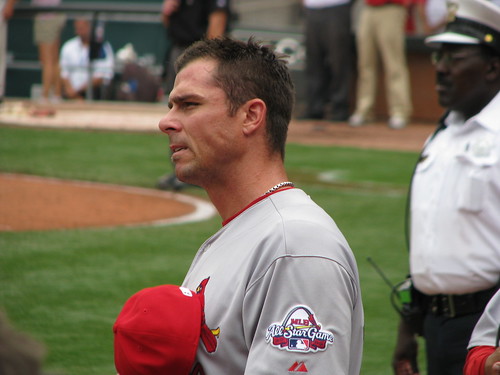 |
| Hats off to you Photo by chetthejet |
As it happened, maybe Ankiel could have used a little chemical depressant in his system. I won't even rehash his 2001. It was painful to watch. It was painful to hear about. It was painful to have in the back of my mind as something I knew was going on even while I didn't have a ton of time to consume baseball. I'm not anything like a Cardinals fan, but hey, Mark McGwire was slugging .492 with a sub-.200 batting average while J.D. Drew hit like a Hall-of-Famer (specifically Mickey Mantle, given the time he missed due to injury), and I've always been a fan, for different reasons, of both guys. Plus, Craig Paquette was on that St. Louis team. So what I'm saying is that I rooted for Ankiel just a few percentage points harder than your typical non-Cardinals fan might have otherwise, and felt just a few percentage points more pain than your typical non-Missourian.
Fun with(out) Sacrifice Bunts

The Newest TPA Member: Unveiled
While Mark is living the dream as a pie-eating southern gentlemen, the rest of us are stuck here on the Internet. The only saving grace is that perhaps my plan of kidnapping Brian McCann so I can keep him in a jar in my basement and ask him questions about pitch-calling might be one step closer to the reality, the truth is: Smith is gone, we have to move on.
And today, I got an email from The Common Man, which surprised me for two reasons.
1. I had no idea that The Common Man had my email address. In fact, I was never really sure if The Common Man knew who I was, other than someone who occasionally RT'd his stories and asked him questions about baseball cards.
2. The content of the email itself was surprising: The Platoon Advantage wanted me. Upon receipt, I sent a message making sure that I was the intended recipient, and was delighted to find that it was indeed me that they wanted.
When someone takes the opportunity to say they admire your work, it is flattering. But when the whole staff at TPA echoed that sentiment and encouraged me to join the band of misfits, I could not say yes fast enough.
So here I am: Mark Smith's replacement. And that's a huge pie-tin to fill.
In case you don't know me, I'm Cee Angi. I'm a long time reader, first time contributor here at TPA, but I am no stranger to the Internet or the world of baseball writing.
For as long as I can remember, I have been writing. I think I was inspired by Nancy Drew and Harriet the Spy, who were always armed with a notebook and ready to investigate or write at a moments' notice. Writing became a welcome distraction for an awkward kid who bounced around the country from school to school, as my family relocated constantly.
I started the Internet writing by piecing together columns of anything baseball related and shopping them around to strangers. I joined Twitter, followed a lot of people, and I was in awe of those who could write and run their own sites successfully. There was a great deal of envy and jealousy towards people who were living the dream as paid writers, or just bloggers with well-respected sites that generated a lot of traffic.
After a short time, I started to get noticed as I covered the Chicago White Sox for a publication while I attended grad school there. In conjunction, I started my own site: Essence of Baseball, which focused mostly on AL East, specifically the Boston Red Sox. Because of that site's success, and perhaps my prolific and erratic Twitter account, I was asked to join a team of tremendous writers at Over the Monster, the Red Sox site on SB Nation.
My strong suit, beyond the typical baseball analysis, has been a side project: Baseball-Prose. What started as a frustration for not having a place to write narratives and short stories has spiraled into a site that houses reflections of my childhood, adult-hood, and my dating life, as they relate to baseball. This year has been fun with contributions from other writers frustrated that there are limited outlets for narratives and prose, including TPA's own Jason Wdhjwhateverhislastnamereallyis.
If it's not already evident, I'm a lady. More specifically, a 20-something living in Washington, DC after a three-year stint in the best city around: Chicago. Even though I'm a chick, I can bro out with the best of you. I have an affinity for statistics (not just baseball ones... they also consume my professional life). I am an avid bourbon drinker, and my two loves other than baseball are ice hockey and my cavalier spaniel, Lola.
Being a minority in the baseball world is a blast and I have worked hard to establish some legitimacy, even though I got awkward stares last weekend for showing up to Sabr Day in high heels and lip-gloss. One man actually asked me, "Are you sure you're supposed to be here?" Awkward.
The bottom line? I'm happy to be here, I'm honored by the opportunity, and I will do my damnest to provide you all with entertaining and informative content the best way I know how. Until the next post, follow me on Twitter: @CeeAngi.
And perhaps the most important part of my introduction: Cake.
Monday, February 6, 2012
A Farewell and a New Beginning
Friday, February 3, 2012
What To Say About Josh Hamilton?
I’ve been sitting here trying to figure out what to say about Josh Hamilton. It’s been exceptionally difficult. All I feel is sadness for the man and for his family. That’s, apparently, not what I should be feeling.
I think Jeff Passan wants me to be angry at Hamilton for not caring enough about his sobriety, or maybe angry at the concept of addiction. But Passan’s writing is so muddled that it’s impossible to tell if he’s got an actual point to make about Hamilton’s behavior or not. Mostly, it’s about Hamilton’s failure on Monday night. (Update: In the interest of fairness, Jeff and I talked on Twitter and he said the following: "The column's point was about the difficulty bordering on impossibility of sobriety and how it tripped up Hamilton. That even the strongest man or woman can be waylaid, and that it's not wrong to lose that care. It's addiction's worst symptom." I still feel like his point was muddled, but I appreciate the sentiment he was going for.)
I know that Randy Galloway wants me to be angry at the MLBPA, because it has inspired Josh Hamilton not to re-sign with the Rangers, who apparently really care about him as a person or something, for less than market value. The Rangers, who have nurtured Hamilton and kept him away from his demons, except for those two times, always have had his back according to Galloway and that nasty union wants just cares about how much money the former MVP will make.
I know that commenters want me to be angry at the media for even bringing this up. Josh Hamilton is a grown-ass man, they write, and has a right to a drink if he wants one. Others are turned off by this very human story, and believe it’s a matter only relevant for Hamilton and his family. Ignore it, they say.
Thursday, February 2, 2012
Returns on trades of free agent one-year contracts
by Jason Wojciechowski
Mediocre teams sign mediocre players to one-year deals every off-season, and every off-season, fans mutter things like "if he pumps up his value, he can be flipped for something." But can he?
Using the magic of Baseball Prospectus's transactions database combined with the transaction listings at Baseball-Reference, I compiled what I believe is a complete list of players who signed one-year free-agent deals before 2011 and who were subsequently traded. It's very possible that I've missed someone because I did it more or less manually, so you should tell me who I missed, and I'll add them in, but here is what I found:

